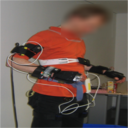25C3 - 1.4.2.3
25th Chaos Communication Congress
Nothing to hide
| Speakers | |
|---|---|
|
|
Kai Kunze |
| Schedule | |
|---|---|
| Day | Day 1 (2008-12-27) |
| Room | Saal 2 |
| Start time | 16:00 |
| Duration | 01:00 |
| Info | |
| ID | 2892 |
| Event type | lecture |
| Track | Science |
| Language used for presentation | en |
| Feedback | |
|---|---|
|
Did you attend this event? Give Feedback |
About Cyborgs and Gargoyles
State of the Art in Wearable Computing

In this talk I present the current state of wearable computing, computing as common and useful as clothes, focusing on activity recognition (the inference of the users current actions) using on-body sensors (accelerometers, gyroscopes and other modalities), explaining possibilities, dealing with challenges and limitations and presenting some perils.
Introduction
The visions of ubiquitous / pervasive computing more and more becomereality. Everyday, we are surrounded by a multitude of computing devices. However, as of today, they fulfill very limited functionality and often are more distractive than useful. In my talk I will present research efforts to eliminate this gap and to enable everyday technology to support us during real life without hinderance or annoyances focusing on wearable technology. Using portable devices that accompany us like clothes, we are supported by computing not relying on any kind of infrastructure and augmented spaces. I focus in my talk specifically on the state of the art in activity and context recognition.
Application scenarios
First, I will give some application scenarios from European Union Projects, we at the Embedded Systems Lab at the university of Passau are currently involved in. This includes WearIT@Work, a 30 Million Euro integrated project with over fifty partners. I will show short movies about some work we did at Skoda to support assembly line work and work involving maintenance work support for Zeiss technicians using Heads-up displays. The next application scenario to tackle is Healthcare. Here we work closely with the Hospital in Steyr, Austria, supporting doctors doing their rounds using RFID technology and capacitve sensing. Another aspect is also health and lifestyle, an interesting personal hobby project involves trying to recongize Kung-Fu and Tai Chi gestures.
Enabling technologies
In this seciton of the talk, I will go into more details about what sensors and modalities can be used to detect which activities/ user states etc. From the pervasive accelerometers and gyroscopes integrated in a lot of gadgets (from mobile phones to entertainment consoles) over using a in-ear microphone to get chewing sounds and detect some kinds of food to a mobile phone that can detect the types of surfaces using simply vibration and audio fingerprinting. Other enabling technologies developed at ESL Passau include magnetic coils for distance measurements and fabric stretch sensors for muscle activity. Most state of the art context and activity recognition techniques rely on a fixed number of sensors with known position and orientation. As part of an effort to facilitate wearable activity recognition using dynamically changing sets of sensors integrated in everyday appliances such as phones, PDAs, watches, headsets we try to tackle some key issues of such systems as detecting automatically on-body device position and developing displacement indifferent classification algorithms. I will also mention a context logger application developed by Tobias Franke, a student writing his diploma thesis at our institute. The application enables to save data from the iPhone "sensors": audio, acceleration etc. to file and label it with some acitivity/ state label for later analysis.
Opportunistic Sensing
In this section, I will present some problems with current activity/context recognition technologies and our efforts to overcome them.
Finally, we will assess how useful these technologies and what possible privacy issues are.
